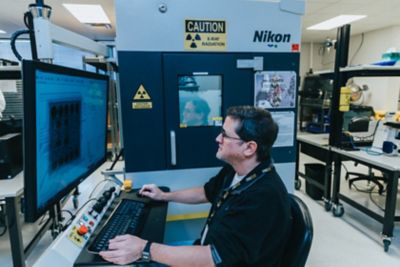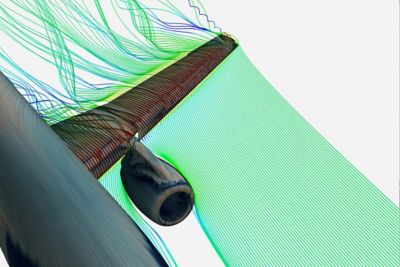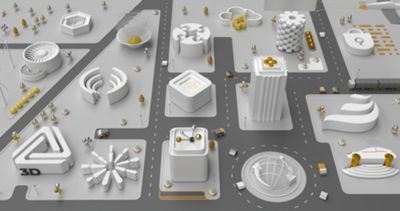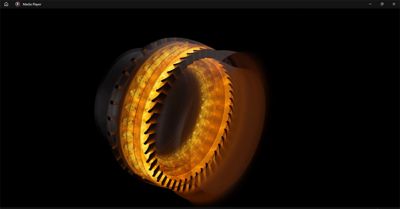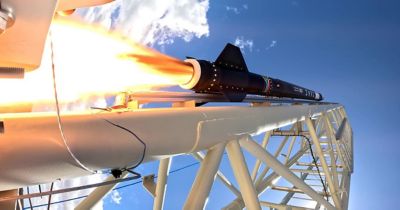Ansys Fluent 2025 R1 delivers an impressive list of new capabilities, including GPU solutions for combustion, acoustics, and free surface flows; solver speedup and accuracy improvements for aerospace and electrochemical applications within the Fluent CPU solver; and major productivity improvements when meshing and setting up assemblies with many zones, with GUI operations 3–500X faster and overall setup time 4–15X faster.
Expanded Use Cases for the Fluent GPU Solver and a New License Option
New physics supported in the Ansys Fluent GPU solver in Ansys 2025 R1 include:
- The FGM (flamelet-generated manifold) model, which provides accurate and efficient combustion modeling for gas turbines and other combustion applications
- Aeroacoustics, with a hybrid GPU/CPU solution using the Ffowcs Williams–Hawkings (FW-H) model
- Surface-to-surface radiation modeling, providing an efficient radiation solution for transparent media
- Particle modeling with discrete phase models (DPM), including mass transfer to the gas phase for evaporating particles
- Compressible liquids to model applications such as water hammer
- Volume of fluid (VOF) method for free surface flow modeling (β)
A large eddy simulation (LES) of an aircraft with 1 billion cells was solved in less than a day using the Ansys Fluent GPU solver.
These capabilities enable new use cases to benefit from the massive performance speedups enabled by the Fluent GPU solver, including gas turbine combustion, aeroacoustics, electronics cooling, mixing studies, and many more.
Watch the Fluent 2025 R1 GPU solver on-demand webinar to learn more.
A new license type is also available for 2025 R1. The new Ansys CFD HPC Ultimate license removes HPC barriers, allowing Fluent to run on any number of CPUs or GPUs without the need for additional HPC licenses. To see if this option fits your business and design needs, contact Ansys Sales.
Fluent GPU Solver Speed-Up Benchmarks
In the graphs provided, we see that the Fluent GPU solver exponentially decreases simulation solve times compared to solving on CPUs.
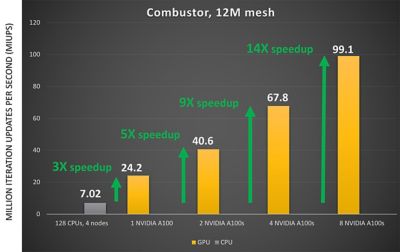
Solving a 12-million-cell combustor simulation on the Fluent GPU solver using the FGM model on eight NVIDIA A100s results in a 14X speedup when compared to CPU hardware.
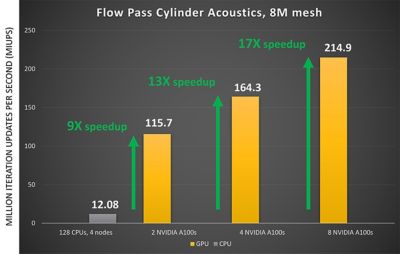
Solving an 8-million-cell acoustics simulation on the Fluent GPU solver using the FW-H model on eight NVIDIA A100s results in a 17X speedup compared to CPU hardware.
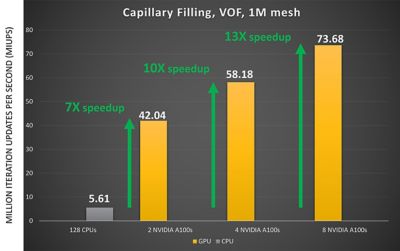
Solving a 1-million-cell capillary filling simulation on the Fluent GPU solver using the VOF method on eight NVIDIA A100s results in a 13X speedup compared to CPU hardware.
With the new capabilities available in the Fluent 2025 R1 GPU solver, you can run much faster simulations compared to traditional CPU hardware and spend more time analyzing results and optimizing designs. New capabilities are added into the Fluent GPU solver at each software release. Access the Ansys Fluent GPU solver FAQ page to learn more.
UI/UX Enhancements
Fluent Web Interface Updates
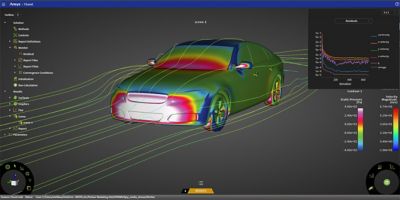
In 2025 R1, you can now mesh, solve, and post-process in the Fluent web interface.
Last year, Ansys launched the Fluent web interface: a way to access Fluent software remotely via a web browser and make changes in real time while calculations are running. In 2025 R1, the watertight meshing (WTM) workflow is available as (β) in the Fluent web interface to continue the drive toward an end-to-end workflow within a single UI.
In addition, the web server URL can now be delivered directly to your email inbox for ease of connection to the server. Limited permission settings are now also available when sharing a web server URL with colleagues for collaboration. Several graphics enhancements have also been made, including particle track support, auto-refresh of graphics objects during simulation, solution animation playback, and more to improve the post-processing experience.
Fluent Desktop Updates
For the Fluent desktop interface, we’ve made substantial performance improvements for cases with many zones to speed up the overall meshing and setup time. This is particularly beneficial for applications with thousands of zones, such as batteries, fuel cells, full vehicle models, and more. Many meshing and setup operations are now orders of magnitude faster, including up to 5X faster solution initialization and cell zone copying, up to 500X faster processing of physics changes, and up to 10X faster auto-pairing of one-to-one interfaces.
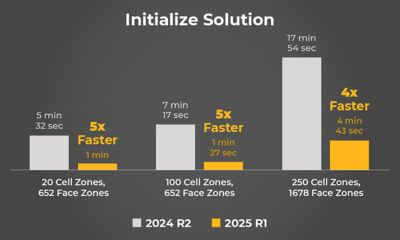
Ansys 2025 R1 solution initialization time compared to 2024 R2 shows substantial speedup improvements.
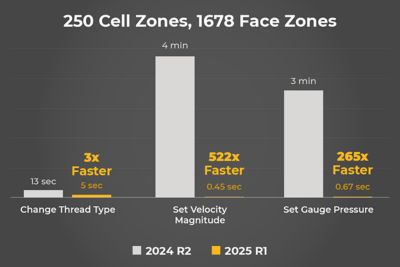
The Ansys 2025 R1 model setup time compared to 2024 R2 is exponentially faster.

One-to-one auto-pairing for nonconformal interfaces is 6-10X faster compared to the prior release.
Fluent CPU Solver Physics Updates
A number of physics enhancements have been made in 2025 R1 to improve industry-specific application workflows.
Electrochemical Applications
Electrochemical modeling enhancements include solver robustness improvements for Li-ion battery models, significantly reducing the necessary number of iterations per time step from hundreds to ~20, enabling speedups that are orders of magnitude faster for simulation runtimes.
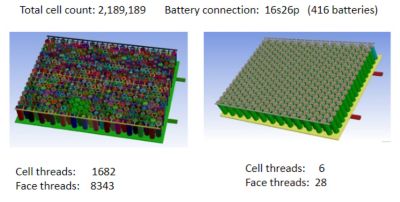
New updates in 2025 R1 significantly reduce the number of time steps needed for Li-ion battery models.
Variable-based battery connections now replace zone-based connections to mitigate bottlenecks for connecting many zones, resulting in much faster solve speeds.
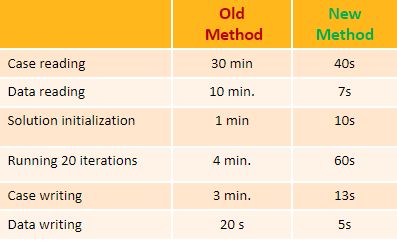
Variable-based connections replace zone-based connections to improve case and data reading and writing, as well as solution initialization and run times.
Finally, best practices are now available for electrolysis modeling to provide a robust workflow and solution strategy, which are accessible here.
Aerospace Applications
Aerospace application enhancements for users working on designs with rotating blades, such as helicopters or drones, include the automatic creation of rotor disc zones (floating discs) before solving when using the virtual blade model (VBM). This significantly reduces preprocessing time and allows for easy repositioning of rotors in the solver.
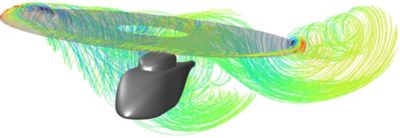
The virtual blade model (VBM) in Fluent software replaces 3D rotors with actuator discs that introduce the effect of the rotors via implicit momentum source terms in the governing equations.
Updates to the Fluent Aero workspace include mesh adaption and parametric search (β) workflows that enable users to restart and continue to update mesh adaption or parametric search cycles for all design points, stop a mesh adaption or parametric search cycle using convergence criteria, and post-process all cycles for all design points.
Meshing Speedup Enhancements
Significant task performance speedup improvements have been made in 2025 R1 for the WTM workflow. For tasks such as importing geometry, updating tables, patterning regions, and more, speedup factor improvements between 3-350X were observed for cases with a large number of zones.
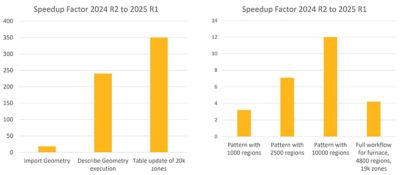
Significant speedup enhancements were made to the watertight meshing workflow in 2025 R1.
Similar task performance speedup improvements have been made for fault-tolerant meshing (FTM) workflows. For example, a case with over 200,000 parts showed up to a 32X performance improvement for specific tasks and 8X faster for the complete workflow. From file loading to task switching and drag and drop, significant speedup improvements were made to improve your overall workflow time and productivity.
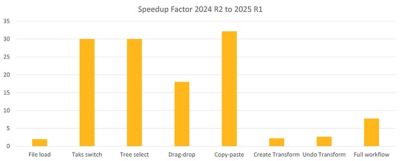
Task performance improvements within the fault-tolerant meshing (FTM) workflow for cases with 200,000+ parts
Where Can I Learn More?
To learn more about Ansys Fluent 2025 R1 software updates, you can:
Watch Fluent 2025 R1 software webinars on demand.
Access the Fluent 2025 R1 Documentation Help Site.
Access the full “What’s New” presentation on the Ansys Customer Portal.
Download the latest version of Fluent software at the Ansys Customer Portal.







